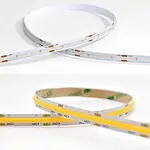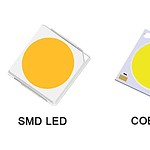Are you thinking of having a super color combination for your smart home, office, or workplace? This may drive you into the deep sea, full of confusion and absurdity that you cannot spell out. And you will see several options when choosing LED lights to get a premium feel. So, I will share every ins and outs with distinctions between RGB vs. RGBW vs. RGBIC vs. RGBWW vs. RGBCCT LED Strip Lights in this comprehensive guide.
RGB, RGBW, RGBIC, RGBWW, and RGBCCT indicate the color variations of LED strip lights. They have different diode combinations that make them unique. Besides, RGB, RGBW, and RGBWW have differences in the tone of white. And other LED strips can’t produce the multi-color effect as RGBIC LED strips.
So, read further to learn more differences between them-
What is LED Strip Light?
LED strips are flexible circuit boards with densely arranged SMD LEDs. These strips have adhesive backing that supports surface mounting. Plus, LED strips are flexible, bendable, durable, and energy-efficient. They also come in a wide range of colors. That makes them versatile and ideal for multi-purpose lighting.
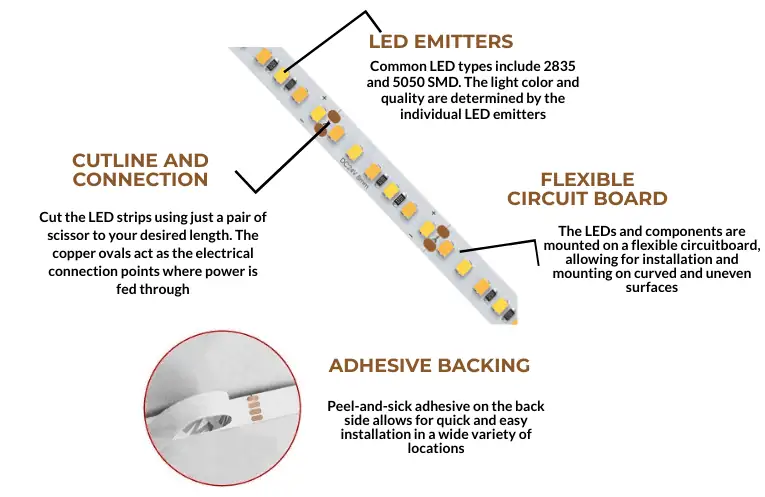
What Do The Below Letters Mean In LED Strips?
The term LED stands for Light Emitting Diode. These diodes are paced in several chips and arranged densely on a LED strip.
A single LED chip can have one or more than one diodes. And the color of these diodes is indicated by the initials of the color name. So, the letters on the LED strip define the color of the emitted light. Here are some abbreviations that you should know to understand the shades of LEDs better-
RGB- Red, Green, Blue
W- White
WW- White and Warm White
CW- Cold White
CCT (Correlated Color Temperature)- Cold White (CW) and Warm White (WW)
IC- Integrated Circuit (built-in independent chip)
| Label | Description |
| RGB | A single three-channel LED chip with Red, Green, and Blue diodes |
| RGBW | One four-channel LED chip with Red, Green, Blue, and White diodes |
| RGBIC | A three-channel LED chip with Red, Green, and Blue + a build-in independent Chip |
| RGBWW | One four-channel chip with Red, Green, Blue, and Warm White |
| RGBCCT | Five-channel chip with Red, Green, Blue, Cold White, and Warm White |
What is RGB LED Strip Light?
RGB LED strip indicates a 3-in-1 chip of red, green, and blue color. Such strips can form a wide range (16 million) of shades by mixing red, green, and blue. An RGB LED strip can also produce a white hue. But the white by these strips is not pure white.
Yet, the color-producing capability of RGB depends on your controller type. An intelligent controller allows mixing options to create your desired color in the strips.
What is RGBW LED Strip Light?
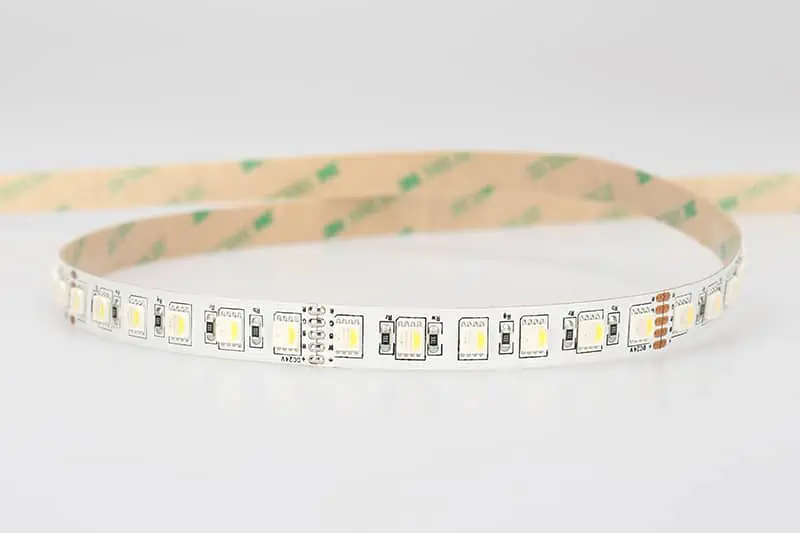
RGBW LED strips contain a 4-in-1 chip with red, green, blue, and white LEDs. So, besides the million hues produced with RGB, RGBW adds more combinations with the extra white diode.
Now, you might question why to go for the extra white shade in RGBW when RGB can produce white. The answer is simple. The white in RGB is emitted by combining red, green, and blue. That is why this color is not pure white. But with RGBW, you will get a pure shade of white.
What is RGBIC LED Strip Light?
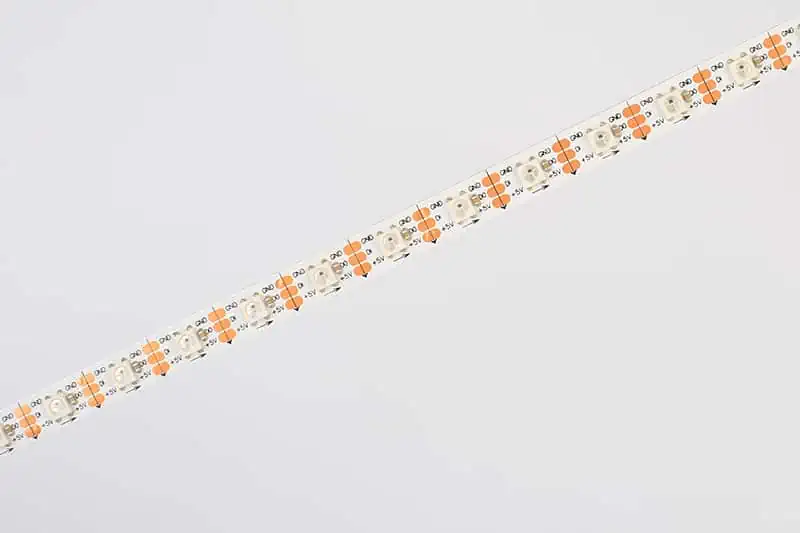
RGBIC combines a 3-in-1 RGB LED plus a built-in independent chip. In the case of color variety, these LED Strips are the same as RGB and RGBW. But the difference is that RGBIC can bring multiple colors in a single strip at a time. Thus, it gives a flowing rainbow effect. But, RGB and RGBW cannot provide this multi-color option.
For more information, you can read The Ultimate Guide To Addressable LED Strip.
What is RGBWW LED Strip Light?
RGBWW LED strips contain five diodes in a single chip with red, green, blue, white, and warm white LEDs. It may also be formed by combining a 3-in-1 RGB chip with two separate white and warm white LED chips.
The significant difference between an RGBW and RGBWW is in the shade/tone of white hue. RGBW emits a pure white hue. Meanwhile, the warm white of RGBWW adds a yellowish tone to the white. That is why it creates warm and cozy lighting.
What is RGBCCT LED Strip Light?
CCT indicates Correlated Color Temperature. It allows CW (cold white) to WW(warm white) color-adjustable options. That is, RGBCCT is a 5-in-1 chip LED, where there are three diodes of RGB along with two diodes for white (cold and warm white).
For different temperatures, the color of white appears different. With RGBCCT, you get the option to adjust the color temperature. And thus can choose the ideal white shades for your lighting.
Thus, including CCT with RGB allows you to get yellowish (warm) to bluish(cold) tones of white. So, if you are looking for customizable white lighting, RGBCCT LED strips are your best choice.
RGB Vs. RGBW
The differences between RGB and RGBW are-
- RGB is a three-in-one chip with red, green, and blue diodes. In contrast, RGBW is a 4-in-1 chip, including an RGB and a white diode.
- RGB LED strips combine the three primary colors and can produce 16 million (approx) shade variations. Meanwhile, the extra white diode in RGBW adds more variations in the mixing of the colors.
- RGB is cheaper than RGBW. That is because the white diode added to the RGBW makes it expensive compared to RGB.
- The white hue produced in RGB is not pure white. But the white light with RGBW emits an accurate shade of white.
So, if you are looking for affordable LED strips, you should go for RGB, considering the above differences. But, the RGBW is best for more accurate white lighting.
RGBW Vs. RGBWW
The differences between RGBW and RGBWW LED strips are as follows-
- RGBW contains four diodes in a single chip. Meanwhile, RGBWW has five diodes in a single chip.
- RGBW has only one white diode. But RGBWW has two white diodes- white and warm white.
- An RGBW gives pure/accurate white lighting. In contrast, the white of RGBWW gives a warm (yellow) tone.
- The price of RGBWW is a bit higher than RGBW. So, RGBW is a cheaper option compared to RGBWW.
Hence, these are the major differences between RGBW and RGBWW.
RGB Vs. RGBIC
Now let’s look at the differences between RGB and RGBIC below-
- The RGB LED strips consist of 3-in-1 LED chips. In contrast, RGBIC LED strips consist of 3-in-1 RGB LED chips plus one independent control chip.
- The RGBIC LED strips can produce a flowing multi-color effect. All the color combinations formed with red, green, and blue will appear in segments creating a rainbow effect. But RGB doesn’t produce colors in segments. It will only have a single color throughout the strip.
- RGBIC LED strips allow you to control the color of each segment. But, the entire strip of RGB produces a single color. So, no facilities for color changing in segments with RGB LED strips exist.
- RGBIC offers you more creative lighting combinations than RGB.
- RGBIC is quite expensive in comparison to RGB. But that’s entirely fair, as RGBIC provides you with a wide range of coloring and controlling options. So, it is worth the price.
Therefore, RGBIC is an excellent option if you are looking for more sophisticated lighting for your place. But, considering the price, you can also go for RGB.
RGB vs. RGBW vs. RGBIC vs. RGBWW vs. RGBCCT LED Strip Lights
Let’s go through a side-by-side comparison between RGB, RGBW, RGBIC, RGBWW, and RGBCCT-
| Feature | RGB | RGBW | RGBWW | RGBIC | RGBCCT |
| Number of Diodes/chip | 3 | 4 | 5 | 3+ build-in IC | 5 |
| Light Intensity | Bright | Ultra-Bright | Ultra-Bright | Ultra-Bright | Ultra-Bright |
| Color Shifting | Single | Single | Single | Multiple | Single |
| Cost | Normal | Medium | Medium | Expensive | Expensive |
How to Choose Between RGB, RGBW, RGBIC, RGBWW, And RGBCCT LED Strip Lights?
You may get confused when choosing the ideal LED strip for your lighting project. No worries, here I’ve discussed how to choose between all these LED strips-
Budget
Considering the price, the most reasonable option for LED flexible strips is RGB. These LED strips come in 16 million different hues with a combination of red, green, and blue. Again, if you are looking for white color LED strip, RGB can also work. But for pure white, RGBW can be your best pick. Plus, it is reasonable compared to RGBWW. Yet, if the price is not a matter of consideration, RGBCCT is excellent for adjustable white hues.
Permanent White
When choosing white, you must consider the tone of white you want. For instance, if you want pure white, then RGBW is an ideal choice. But, again, for a warm white, RGBWW is best. This LED strip will give you a yellow-white creating a warm and cozy atmosphere.
Adjustable White
RGBCCT is the best option for adjustable white color LEDs. This LED strip allows you to choose different shades of white. You can choose from a warm to cool tone of white, each of which will give a different outlook. RGBCCT is excellent because it combines all the functions or combinations of RGB, RGBW, and RGBWW in it. So, no doubt it is a better option. But these advanced features also make it expensive compared to the other LED strips.
Color Changing Option
The color-changing options for LED strips vary with the type of strip and controller you use. With RGB, you get 16 million color-combining options. And the inclusion of extra white in RGBW and RGBWW adds more variations to these combinations. Yet, RGBIC is the most versatile color-adjusting option. You can control the color of each segment of an RGBIC LED strip. So, you get multi-color in a single strip when going for RGBIC.
Therefore, analyze the above-mentioned facts before choosing any of the LED strips.
How to Choose RGB, RGBW, RGBIC, RGBWW, and RGB-CCT LED Strip Controllers?
LED strip controller is a crucial component to consider while installing a LED strip. The controller works as the switch of the strips. Moreover, the color changing and dimming are all controlled by it.
There are numerous options for selecting an LED strip controller. These are-
RF LED Controller
RF stands for radio frequency. Thus, the LED controller that controls the LED lighting with a radio frequency-operated remote is called an RF LED controller. Such LED controllers are popular in the budget-friendly category of LED controllers. So, if you are looking for an affordable LED strip-controlling option, the RF LED controller is a good choice.
IR LED controller
IR LED controllers use infrared rays to control LED strips. They can work within a range of 1-15ft. So, if you choose an IR LED controller, you must keep the controlling distance in mind.
Tunable White LED Controller
The color temperature of LEDs is controlled with a tunable white LED controller. Such a controller can give you the desired shade of white by adjusting the color temperature. For example- at 2700K, the output white light will produce a warm tone. Meanwhile, for a calm tone of white, you need to set the color temperature to more than 5000k. Thus, for adjustable white colors, go for a tunable white LED controller.
Programmable LED Controller
Programmable LED controllers are your best choice for color customization. They provide you with DIY coloring options. So, you can mix red, green, and blue at your desired proportion and make customized colors.
DMX 512 Controller
DMX 512 controller is ideal for large installations. These LED controllers can change the color of LEDs tuning with music. So, the light game you watch at live music concerts is due to the magic of the DMX 512 controller. You can also go for this LED controller syncing it with your TV/monitor.
0-10V LED Controller
A 0-10V LED controller is an analog light-controlling method. It controls the intensity of LED strips by changing their voltage. For example, dim the LED controller to 0 volts to get the minimum intensity level. Again, adjusting the LED controller to 10V will produce the brightest output.
Wi-Fi LED Controller
Wi-Fi LED controllers are the most convenient LED controlling system. All you need to do is to connect the Wi-Fi connector to the LED strip (RGB/RGBW/RGBWW/RGBIC/RGBCCT) and control the lighting through your smartphone.
Bluetooth LED Controller
Bluetooth LED controllers are compatible with all LED strips. Connect the Bluetooth controller to your strip, and you can easily control the lighting with your phone.
So, in selecting a LED controller for RGB, RGBW, RGBIC, RGBWW, or RGB-CCT LED Strip, first, choose what effects you want. A programmable LED controller is your best choice for a more versatile color-adjusting option. Again if you are looking for large installations, go for the DMX 512 controller. Though it has a complex setup, you can also use it for smaller lighting projects.
Besides, tunable white LED controllers are ideal when you are looking for adjustable white tones. Apart from all these, you can also go for RF and IR LED controllers for affordable controlling options.
How to Connect an LED Strip Light to an LED Power Supply?
You can easily connect an LED strip light to an LED power supply by following a few simple steps. But before that, let’s know the equipment that you will require –
Required Equipment:
- Wires (Red, black)
- LED power adapter
- Soldering iron
- Cone-shaped wire connectors
- Power plug
After collecting this equipment, go straight to the below steps to connect the LED strip light to the LED power supply-
Step:1: Ensure the voltage of the LED strip light and power supply are compatible. For example, if the voltage of the LED strip is 12V, the LED power adapter should also have a voltage rating of 12V.
Step:2: Next, connect the positive end of the LED strip with a red wire and the negative with a black wire. Use a soldering iron to solder the wires to the strip.
Step:3: Now, connect the LED strip’s red wire to the red wire of the LED power adapter. And repeat the same for the black wires. Here, you can use cone-shaped wire connectors.
Step:4: Take the other end of the power adapter and connect the power plug to it. Now, turn the switch on, and see your LED strips glowing!
These simple steps allow you to connect the LED strips to the power supply.
For more information, you can read How to Connect LED Strip to Power Supply?
FAQs
Yes, you can RGBWW LED strips. There are cut marks on the body of RGBWW strips, following which you can cut them.
Each RGBIC LED can be controlled independently. So, it allows you to transform the RGBIC strips into white.
No, RGBW emits pure white lights. It contains a white diode along with the RGB that gives off accurate white color. But, to get warm white, go for RGBWW. It has white and warm white diodes that provide a yellowish (warm) white tone.
If you want a pure shade of white, then RGBW is better. But, the white produced in RGB is not proper white as it mixes primary colors in high intensity to get white. So, that is why RGBW is a better option. Yet, if the price is your consideration, RGB is a budget-friendly option compared to RGBW.
The types of LED strip lighting can be categorized into two types- fixed color LED strips and color changing LED strips. Fixed-color LED strips are monochromatic strips that can produce a single color. Meanwhile, RGB, RGBW, RGBCCT, etc., are color-changing LED strips.
Though RGBCCT and RGBWW have common color combinations, they are still different. For example, an RGBCCT LED strip has color temperature adjustable functions. As a result, it can produce various shades of white, adjusting its temperature. But RGBWW produces a warm white tone and doesn’t have color temperature adjusting options.
RGBIC includes a separate chip (IC) that allows you to control the lights on each segment of the strips. So, it can produce multi-color hues within the strip. But RGBWW doesn’t have a built-in independent chip. So, it can not create different colors in segments. Instead, it emits a single color throughout the strip.
RGBIC offers you more variations in comparison to RGB. The strips of RGBIC are divided into different segments that emit different colors. And you can adjust the color of each part. But these options aren’t available with RGB as it only offers one color at a time. That is why RGBIC is better than RGB.
As RGBW creates a more accurate shade of white, it is better than RGB. This is because the white shade produced in RGB doesn’t provide a pure white color. Instead, it mixes red, green, and blue to get white. So that is why RGBW is better than RGB.
Dreamcolor LED strips have customizable lighting options. For example, the strips of dream-color LED can produce different colors at different segments. You can also change the color of each part. But RGB doesn’t offer you these customizable options, but they are affordable. Yet, dream-color is worth the extra money for its versatility.
WW stands for warm color, and CW for cold color. In simple words, the white LEDs with WW markings produce a yellowish tone (warm). And the LEDs with CW offer a bluish-white tone (cold).
Though RGBIC has an independent chip (IC), you can still cut and reconnect them. The RGBIC has cut marks, following which you can easily cut them. And also reconnect them using connectors.
Conclusion
RGB is the most basic LED strip compared to RGBW, RGBIC, RGBWW, and RGBCCT. But it is affordable and offers millions of color patterns. Whereas RGBW, RGBWW, and RGBCCT focus on the shade of white.
For pure white, go for RGBW, whereas RGBWW is most suitable for warm white. Besides, selecting an RGBCCT will offer you a color temperature adjusting option. So, you will get more variations of white with RGBCCT.
Yet, RGBIC is the most versatile option among all these LED strips. You can control the color of each LED with RGBIC. So, if you are looking for versatile color-changing options, RGBIC is your best choice.
LEDYi manufactures high-quality LED strips and LED neon flex. All of our products go through high-tech laboratories to ensure the utmost quality. Besides, we offer customizable options on our LED strips and neon flex. So, for premium RGB, RGBW, RGBIC, RGBWW, or RGBCCT LED strip lights, contact LEDYi ASAP!
